Richard Epton has always had a fascination for military airplanes. He grew up on a dairy farm on the east coast of England and his father told him stories about all the airplanes, both English and German, that battled it out in the skies during World War II.
“My father told me stories of what it was like to see the Heinkels, Messerschmidts and Junkers during the war. Dad also took me around to the old military bases to see where the bombers had been,” Epton said. “One day we were out driving when we saw a Spitfire mounted on a post outside of a base. I said, ‘Dad if you sold a few acres of land we could buy one of those,’ and he said, ‘Son, I’ve seen thousands of them. They’ll never be worth anything.'”
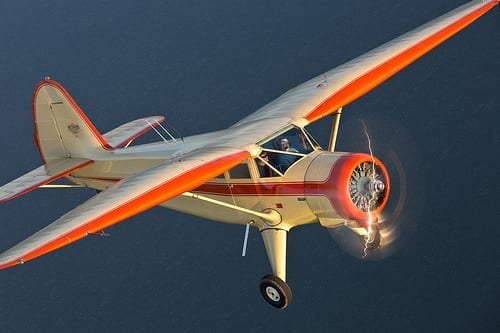 That didn’t stop the younger Epton from looking to get a Warbird of his own. Today he lives in the United States and flies a 1944 Stinson that was pressed into service with the British Navy during the war.
That didn’t stop the younger Epton from looking to get a Warbird of his own. Today he lives in the United States and flies a 1944 Stinson that was pressed into service with the British Navy during the war.
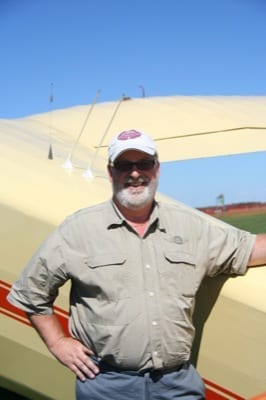 “I looked for one of these for several years,” Epton said as he affectionately patted the tan and orange cowling of the high-wing tail during this year’s SUN ’n FUN. He has owned the airplane for about a year and a half.
“I looked for one of these for several years,” Epton said as he affectionately patted the tan and orange cowling of the high-wing tail during this year’s SUN ’n FUN. He has owned the airplane for about a year and a half.
Although today Epton’s Stinson sports civilian colors, during the war it was designated an AT-19 and was one of 500 sent to Britain for the Royal Navy as part of the Lend Lease Act.
“Instead of being used in the Far East or Europe, it went to Trinidad where it was used to look for U-boats or for radio training,” Epton said. “After the war, about 1946 or so, it came back to the United States and went to Consolidated Vultee to be demilitarized so it could be sold on the civilian market. It was the 77th type that Consolidated Vultee put through their books, and it became known as the V-77.”
Although the airplane began life as a military vehicle, the interior looks more like a luxury automobile from the 1940s. The cockpit is filled with polished wood and rich leather upholstery with hand stitching.
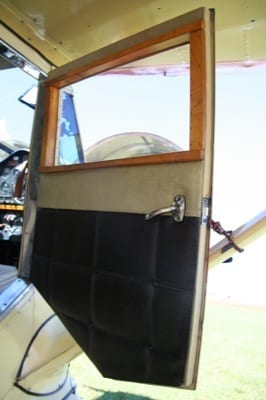 Getting into the Stinson involves climbing two steps that are welded to the fuselage, grabbing a leather strap and pulling yourself into the cockpit. You walk uphill to the front seats or settle into the backseat, which is considerably roomier than modern four-place aircraft.
Getting into the Stinson involves climbing two steps that are welded to the fuselage, grabbing a leather strap and pulling yourself into the cockpit. You walk uphill to the front seats or settle into the backseat, which is considerably roomier than modern four-place aircraft.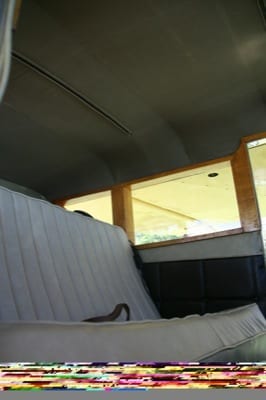
According to Epton, when the airplane was under military use the flight controls and throttle were on the left side of the cockpit and there was a place for the radio operator and observer in the back. The airplane still has large windows. During its military service it also had flare tubes.
When you first lay eyes on a Stinson V-77, you’re struck by how sturdy it looks. The wings, in particular, look thick and strong.
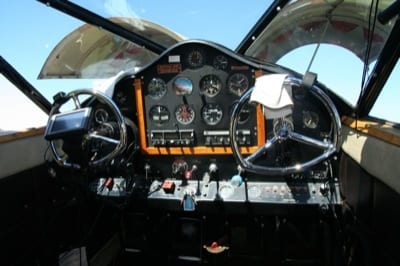 “When Stinson was designing the airplane they wanted a wing that was capable of high lift, something that was reasonably fast, and something that could carry a high load,” Epton said. “They looked at the Stinson Model A tri-motor, which was a low-wing airliner in the 1920s and 1930s. They took that wing, took the two engines off it, shortened it slightly but kept the basic construction.
“When Stinson was designing the airplane they wanted a wing that was capable of high lift, something that was reasonably fast, and something that could carry a high load,” Epton said. “They looked at the Stinson Model A tri-motor, which was a low-wing airliner in the 1920s and 1930s. They took that wing, took the two engines off it, shortened it slightly but kept the basic construction.
“It is an exceptionally strong wing,” he continued. “You could walk from one wing tip to the other. It’s a very thick wing. When you look at it from the trailing edge you will notice that it’s probably a foot and a half thick.”
The fuselage is made of tubular steel. The landing gear looks as if it could handle carrier traps.
“It withstood the rigors of rough fields,” said Epton of the plane, which has a gross weight of 4,100 pounds and a useful load of a bit more than 1,100 pounds. “It is an incredibly stable platform. We don’t normally get the bumps that we have with lighter aircraft that we have flown because it’s so heavy and stable.”
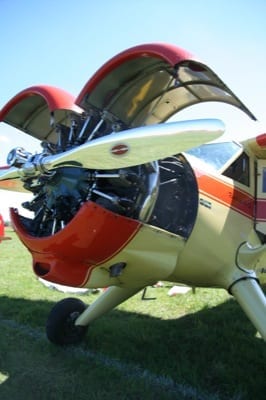 The Stinson, which sports a Lycoming R680-E3B and a Hamilton Standard propeller, boasts a good range as well, he said. It holds 76 gallons of fuel, 38 on each side.
The Stinson, which sports a Lycoming R680-E3B and a Hamilton Standard propeller, boasts a good range as well, he said. It holds 76 gallons of fuel, 38 on each side.
“It is a total gravity fed system with a big carburetor and big pipes,” he said. “When you have a big horse, you have to feed it the hay. On takeoff she indicates 30 gph. In a climb she takes 20 gallons an hour. At regular cruise it’s 16 gallons or you can lean it out for approximately 14 gph, which is about 1,850 rpm with 24 inches of manifold pressure. That gives her an indicated airspeed of approximately 120 mph at 14.2 gph.”
The Stinson is good on the ground as well, according to Epton, who notes that is unusual in a taildragger because the angle of the cockpit usually makes for limited forward visibility.
“The Stinson is the exception,” he said. “From the left seat I can’t see the right quadrant. However, whenever I go to airshows I always have someone in the right seat to be safe.”
The instrument panel is a mixture of old and new. In addition to vintage instruments, Epton has a Garmin GPS unit with electronic sectional and approach plates.
“I’m not going to fly hard IFR with it,” Epton said with a shake of his head. “We also have paper charts and we have a watch and a compass so we have pretty much everything we need.”
Epton’s Stinson is painted a light tan with orange accents.
“The previous owner picked it,” he said. “I repainted the nose-bowl, but that’s it. I didn’t want a gaudy airplane. It’s not a sky rocket, it’s not a newer age airplane. We wanted to retain its character.”
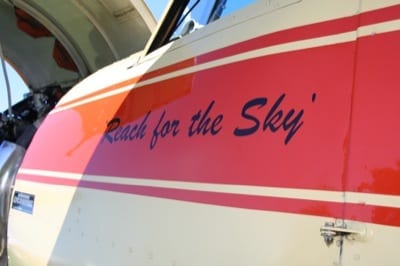 On the side of the cowling the slogan “Reach for the Sky” is painted.
On the side of the cowling the slogan “Reach for the Sky” is painted.
“’Reach for the Sky’ is a movie about a British pilot who lost his legs in an aircraft accident, then went on to fly for the Royal Air Force during World War II. I found it very moving,” Epton explained.
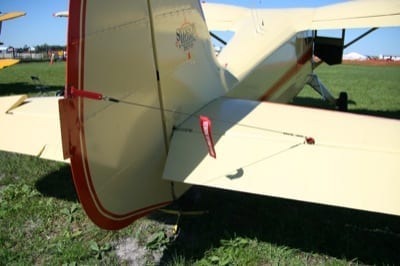 The size of the Stinson’s tail and the rudder always seems to catch the eye of airplane buffs, he noted. Anytime you see a rudder that large you know the engine is producing a lot of thrust, which usually equates to quick takeoffs. During those quick takeoffs in a tailwheel plane there is always the chance the back end will want to come up to visit the front.
The size of the Stinson’s tail and the rudder always seems to catch the eye of airplane buffs, he noted. Anytime you see a rudder that large you know the engine is producing a lot of thrust, which usually equates to quick takeoffs. During those quick takeoffs in a tailwheel plane there is always the chance the back end will want to come up to visit the front.
“She has a lockable tailwheel,” said Epton. “When you pull onto the centerline you push the yoke forward, you add a little throttle and tap on the brakes to lighten the tail for a second to get the tail lined up. Reach down and unlock the tailwheel and add throttle. You push the yoke foreword, and after about two airplane lengths the tail comes up slowly. Let the airspeed increase to about 60 to 70 mph and she’ll climb out.”
 The Stinson is extremely pitch sensitive. The trim actuator is a crank on the ceiling of the cockpit. To activate the trim the pilot turns the crank, like twirling a lasso over his or her head. You need the trim, says Epton, because the tail is so heavy.
The Stinson is extremely pitch sensitive. The trim actuator is a crank on the ceiling of the cockpit. To activate the trim the pilot turns the crank, like twirling a lasso over his or her head. You need the trim, says Epton, because the tail is so heavy.
“If you put the tailwheel on the scale it would indicate 600 pounds, so if you get a flat tire you have to carry a jack because there is no way you are going to be able to lift it by yourself,” he said.
Despite it being such a heavy airplane, Epton’s airplane was picked up and tossed around by the tornado during last year’s SUN ’n FUN.
“Despite having the elevator lock and the rudder locked, the wind still moved that great big rudder,” he recalled. “We came up with a new design for a lock for the elevator and rudder to prevent it from happening again!”
People who read this article also read articles on airparks, airshow, airshows, avgas, aviation fuel, aviation news, aircraft owner, avionics, buy a plane, FAA, fly-in, flying, general aviation, learn to fly, pilots, Light-Sport Aircraft, LSA, and Sport Pilot.
